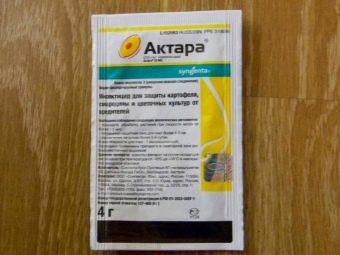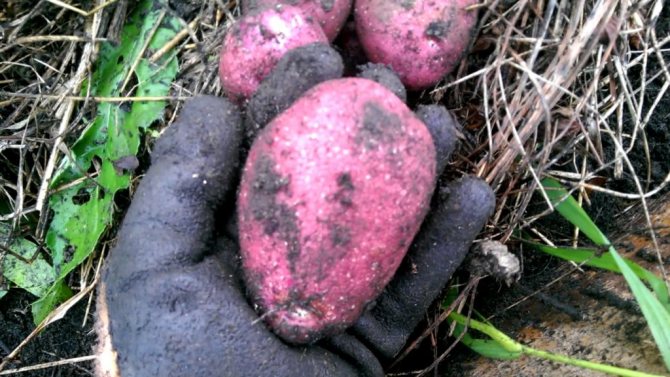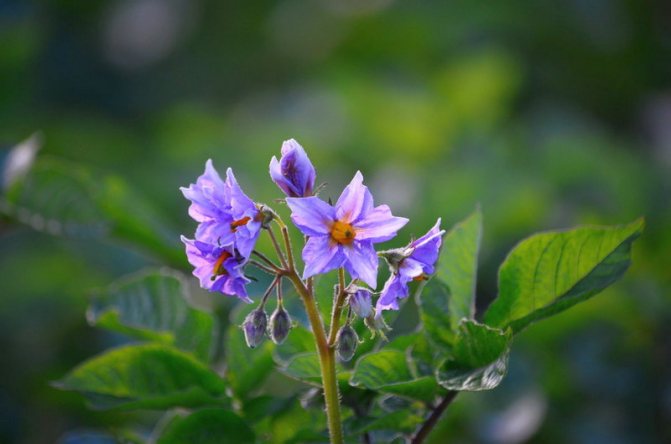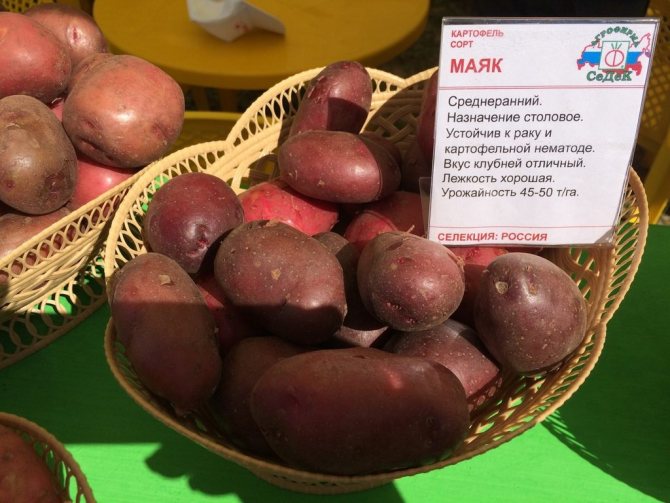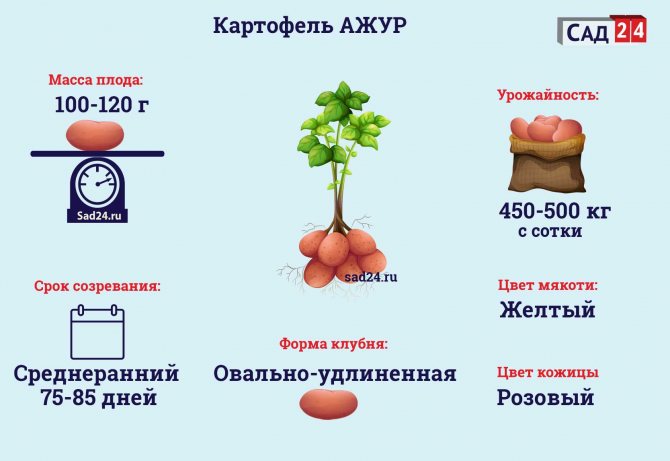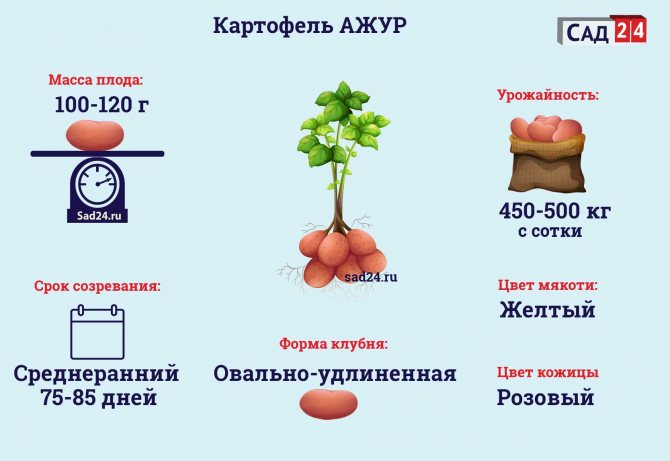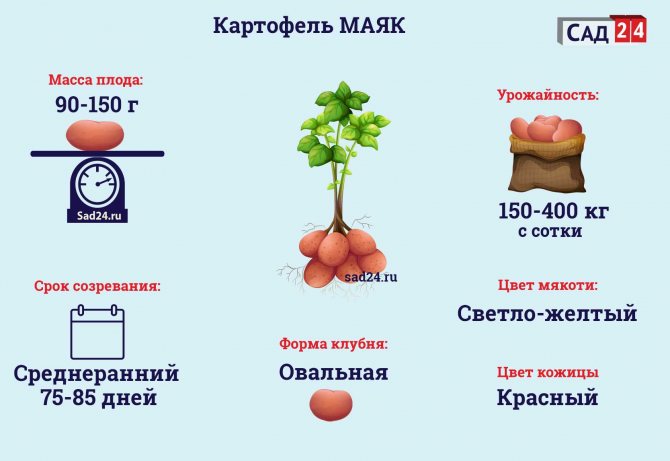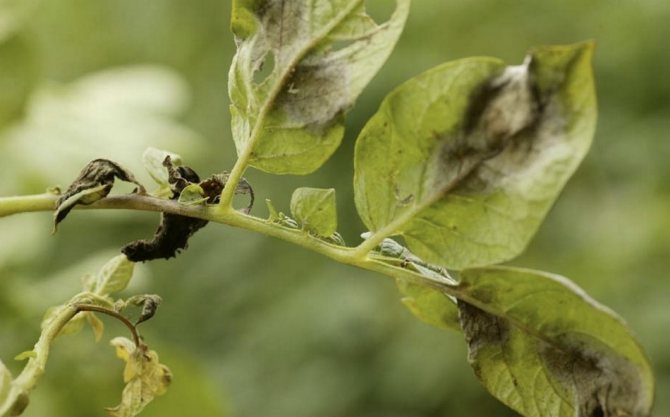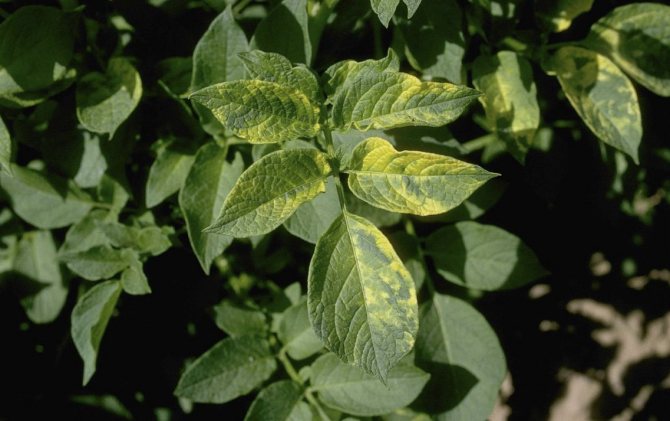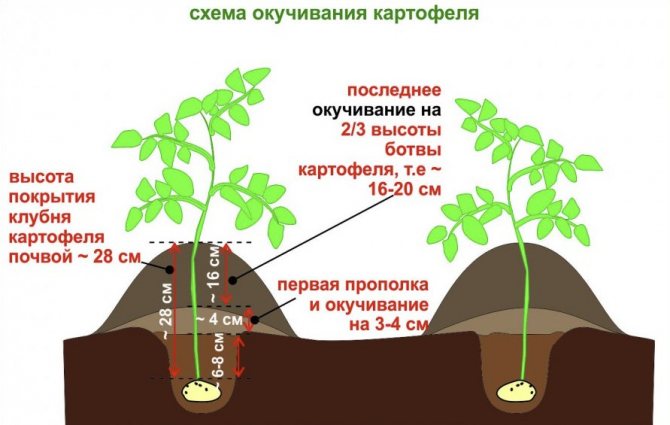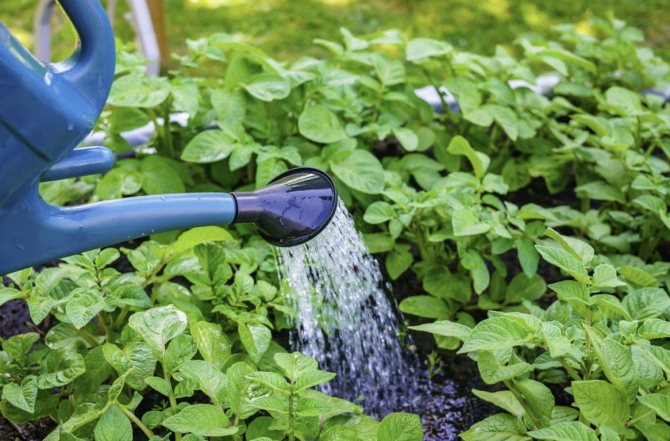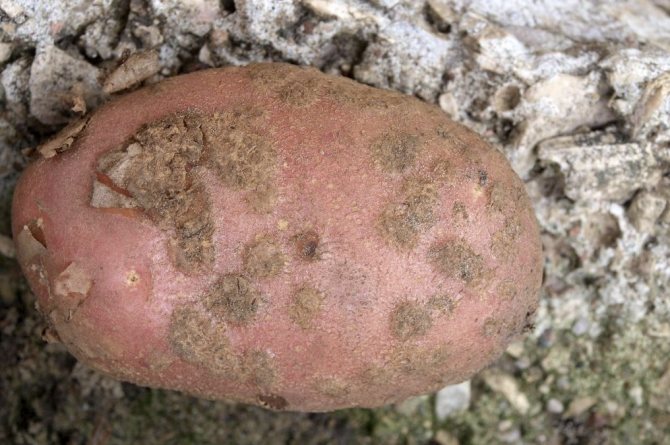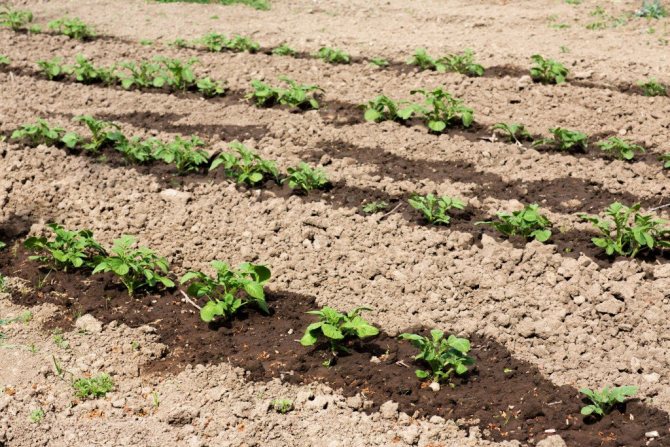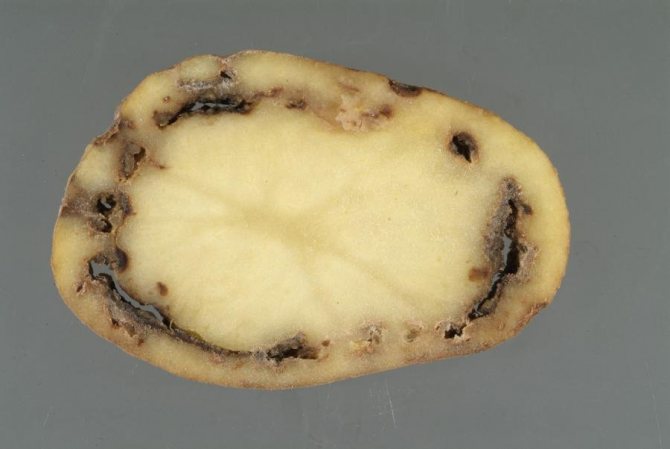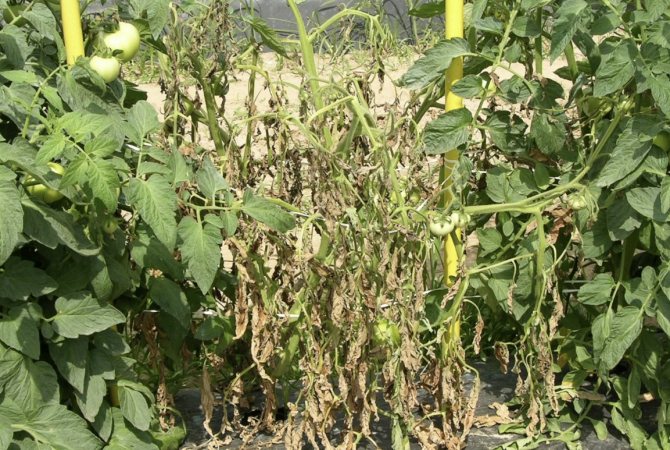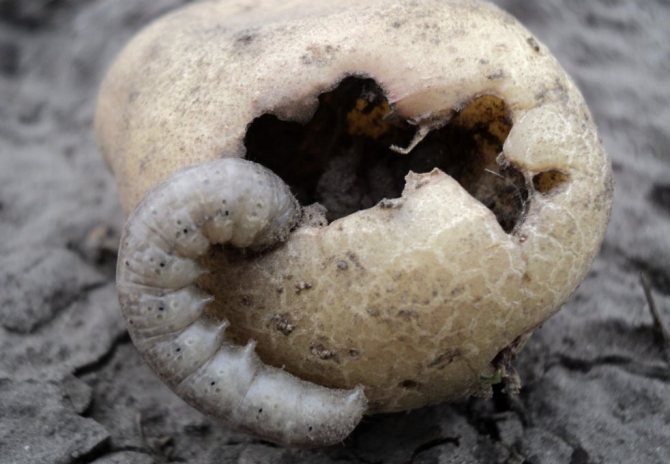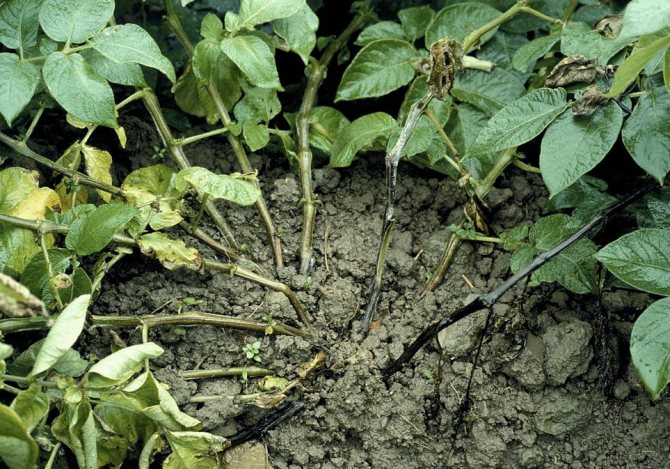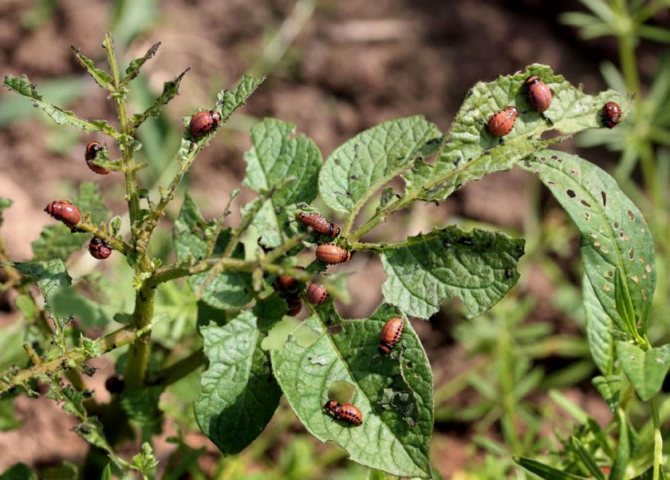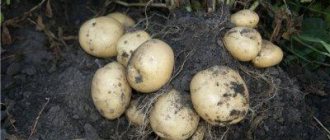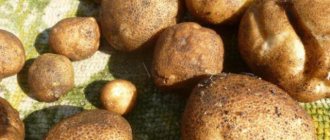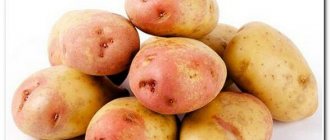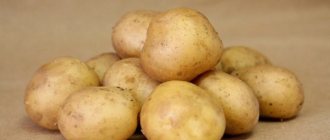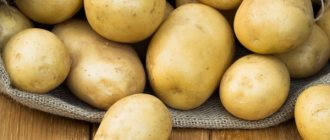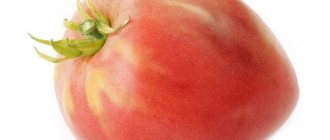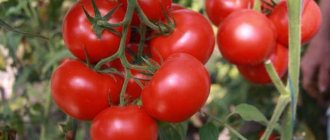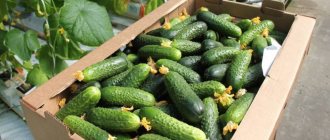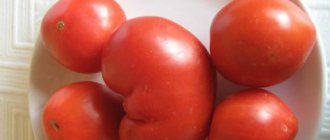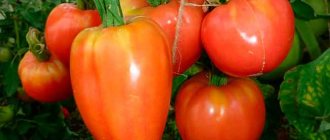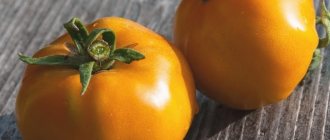Description of culture and features
"Azhur" refers to a mid-early table variety and is quite fruitful. After the shoots are formed and until the vegetable ripens, it usually takes from seventy-five to eighty-five days. The digging process should be carried out about twenty days earlier.
The bush of this plant is characterized by spreading and vigorous growth, the average height is about 50 centimeters. The leaves are evenly spaced, large and dark green in color, as well as a wrinkled structure, wavy edges. The top is a place for the location of inflorescences that have large light lilac flowers.
Potatoes have medium oval tubers that are usually the same. Characteristics of the peel include sufficient firmness and a deep pink color. The tubers are smooth to the touch with small and shallow eyes. The straw-colored pulp contains a lot of carotene. This fruit is delicious and has a bright aroma. Each of the Azhura bushes yields up to fifteen root crops of the same average size. Usually one hectare gives about fifty tons of the crop.
"Azhur" is a potato with a high starch content. This is why it is often used to prepare delicious meals and can be fried, boiled, and stewed.
Breeding history
Azhur is registered in the State Register of the Russian Federation in 2020. It is characterized by high taste properties and is recommended for growing in the temperate climate of central Russia and its central regions. This is the 4th zone of winter hardiness with a minimum winter temperature of -35 ° С. The variety is also adapted to the climate and in regions with higher winter temperatures.
Considering that young tubers can be eaten already on the 45th day, in the southern regions they practice planting Azhura 2 times a year: in early spring and in summer, after harvesting. The originator is the All-Russian Research Institute of Potato Economy, which produced this variety in cooperation with Agrofirma Sedek LLC. The aim of the selection was to obtain high-yield potatoes.
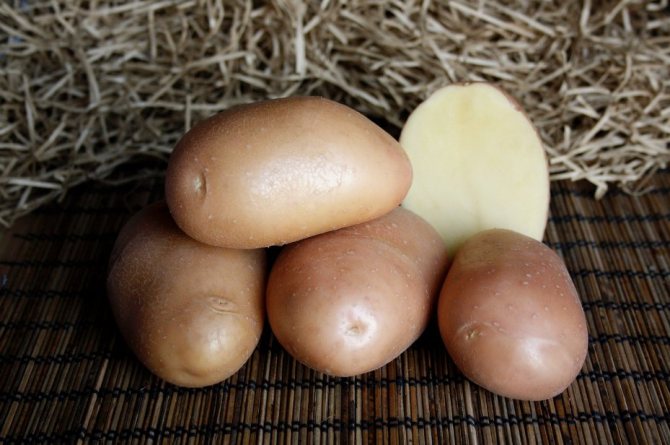
Correct fit
How to plant correctly:
- In autumn, the site is disinfected, fertilized, dug up and removed residues of plant origin and weeds. In the spring, re-digging is carried out;
- Give preference to areas after winter and legumes. It is not recommended to plant potatoes near tomatoes and apple trees;
- Seed material begins to germinate two weeks before planting. First, it is necessary to sort out the planting tubers, rejecting diseased and damaged specimens. Selected planting tubers are pickled and treated with growth stimulants;
REFERENCE: If fertilizers were not applied during the autumn digging, then they are applied to the planting holes directly during planting.
- Planting is carried out at the end of April-beginning of May, in the soil warmed up to +12 ºС;
- An interval of 25 cm is left between the planting holes, the row spacing is kept from 55 to 60 cm.The seed material is buried 5-10 cm.
Advantages of the variety
Potatoes "Mayak" have a large number of advantages that make it promising against the background of other varieties for agricultural complexes or private farmers:
- fairly high yield rates;
- resistance to pathogens of wrinkled and banded mosaic, to damage by golden potato nematode;
- high rates of marketability of the crop;
- good taste of fruits;
- the ability to get a harvest in 75-85 days.
When potatoes are placed on the site after perennial grasses, winter and leguminous crops, as well as annual herbaceous plants, the quality of the yield increases significantly.
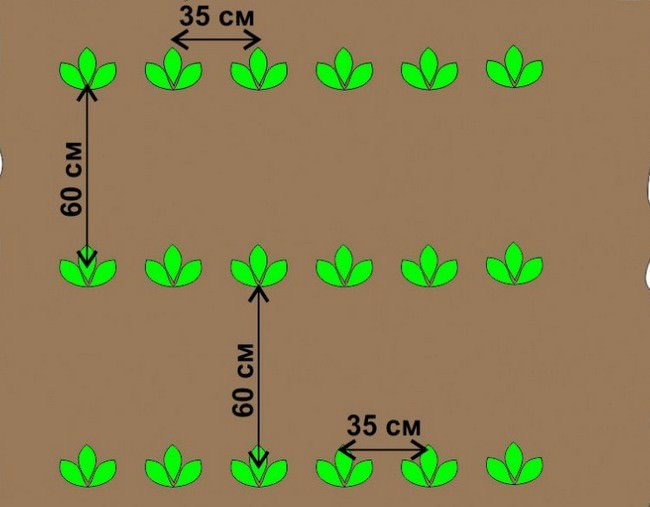

Advantages and disadvantages
Azhur potatoes are quite young, but they have many perspectives. The main positive characteristics of this plant:
- ripens early, for consumption it can be dug in late June or early July;
- has a good presentation and taste, therefore it is often grown for sale;
- gives a good harvest;
- this type of root crop is well stored and does not deteriorate when optimal conditions are created;
- the plant can tolerate drought well, does not need constant watering;
- this type of plant is considered unpretentious to the soil;
- resistant to damage to potato crayfish and scab, as well as late blight.
The disadvantage of "Azhura" is its susceptibility to the influence of the golden nematode. This plantation is often attacked by the Colorado potato beetle, wireworm and moth.
For preventive purposes, the bushes need to be treated with special preparations. An unripe root crop can easily be damaged, the reason for this is its thin skin.
Harvesting and storage
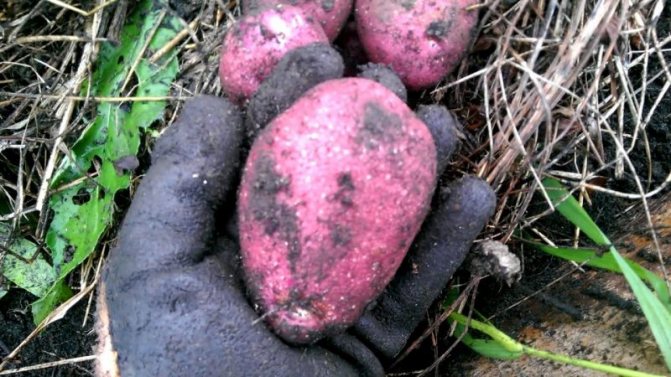

The potatoes planted at the end of May are fully ripe in September. For harvesting, dry weather is chosen so that it is convenient to remove the potatoes with a pitchfork, since it is difficult to dig wet soil.
The dug out potatoes are dried, sorted out and placed in storage. Under proper conditions, the crop retains its presentation and taste until the next season.
How and when to collect
The term is determined by the appearance of the lower leaves on the tops. Yellowing of the foliage indicates that the potatoes are fully ripe. When all the tops turn yellow, harvesting begins.
In order not to damage the tubers with a shovel, pitchforks are preferred. The bush is lifted by the tops, shaken off the ground and transferred to the prepared room.
Features of storage and keeping quality of the variety
The harvested potatoes are laid out on a dry surface in a dark room for 7-10 days to dry. The air temperature is maintained in the room + 14 ... + 17 ° С. The room is regularly ventilated.
After drying, the potatoes are sorted. Rot damaged and dry tubers are discarded. Potatoes with mechanical damage during digging are selected for consumption in the first place. Good ones are placed for long-term storage.
A microclimate is created in the vegetable storage with an air temperature of + 3 ... + 5 ° C, a humidity of 85-90% and regular air circulation. Subject to the recommended conditions, the Mayak variety is stored for 7-8 months. Keeping quality reaches 97%.
Harvesting
Full ripening of the crop occurs during the period of wilting of the tops. While collecting, carefully dig in the bush with a fork and pull it out by the tops. The harvested crop is dried, sorted out, rejecting damaged specimens. After the crop is placed in storage.
We suggest you familiarize yourself with potato varieties with different ripening periods:
| Late ripening | Early ripe | Superearly | Mid late | Medium early |
| Nikulinsky | Borovichok | Forty days | Crane | Yanka |
| Cardinal | Elmundo | Karatop | Sorcerer | Giant |
| Rocco | Felox | Riviera | Mozart | Tuscany |
| Kiwi | Bellarosa | Zhukovsky early | Grenada | Purple Haze |
| Ivan da Marya | Natasha | Farmer | Melody | Openwork |
| Picasso | Ariel | Minerva | Margarita | Santana |
| Asterix | Queen anne | Veneta | Ramona | Desiree |
| Slav | Arosa | Kiranda | Dolphin | Lady Claire |
Potatoes Azhur
Openwork is a young variety that was bred to replace some European varieties of potatoes. It is rapidly gaining popularity among gardeners, as it has an attractive appearance and excellent taste.And the result of the work can be estimated already in July.
Origin story
Azhur potatoes were bred by Russian breeders. The originator of this variety is the Sedek agricultural company. In 2020, a new variety was added to the state register of the Russian Federation. Gardeners began to actively multiply and sell it.
Openwork is recommended for cultivation in the Central region of Russia. This includes Moscow, Ivanovo, Vladimir, Ryazan, Kaluga, Bryansk and other regions. In the southern parts of the country, potatoes can be harvested twice a season.
Description
Openwork is a mid-early table variety that brings a good harvest. From the moment of germination to full maturation of potatoes, 75-85 days pass. But you can start digging it 20-25 days earlier.
The plant forms a sprawling, vigorous bush that can reach up to 45-55 cm in height. Large dark green leaves grow unevenly on it. They have a wrinkled structure and a slightly wavy edge. At the top of the bush are inflorescences of large, light lilac flowers.
Azhura tubers are medium in size and oval in shape. The dense rind is dark pink in color. The surface of the potato is smooth, the eyes are small and shallow. The pulp contains a large amount of carotene, so it has a straw color. The taste is rich, with a pronounced aroma.
The mass of tubers is in the range of 100-120 grams. One bush can produce 8-15 root crops. Gardeners get an average of 45-50 tons of crops from one hectare. Small potatoes are rare, almost all potatoes are the same size.
Potatoes of this variety are characterized by a high starch content (about 14-16%), therefore they are widely used in cooking. Ideal for frying, preparing salads and soups.
Attention! After boiling, the pulp does not darken.
Advantages and disadvantages
This potato variety is very young, but promising. Openwork is characterized by a number of advantages:
- Early ripening. Potatoes for food are dug out already at the end of June - the first half of July.
- Excellent presentation and taste. Suitable for sale.
- High productivity.
- Keeping quality of root crops is 95%. When favorable conditions are created, potatoes of this variety can be stored for a long time without spoilage.
- It tolerates drought well and does not require frequent watering.
- Unpretentious to the composition of the soil.
- It is not affected by potato crayfish and scab, has an average resistance to late blight.
Description
Mayak potatoes are medium early varieties. Bushes of medium height, tops are strong, semi-erect. The leaves are dark green, medium-sized, wavy. The flowers are pale lilac. The bush has a good root system, which allows the formation of 12-18 tubers under each plant.
The variety is easy to adapt to different soils and climatic conditions.
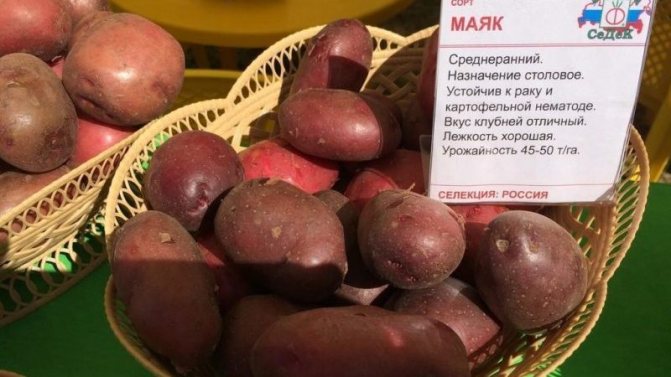

Origin and development
Potatoes Mayak is a table variety. It was bred by breeders of the Federal State Budgetary Scientific Institution "Ural Research Institute of Agriculture".
Recommended for growing in the Volga-Vyatka region: Sverdlovsk, Kirov, Nizhny Novgorod regions, Perm Territory, the Republic of Mari El, the Chuvash and Udmurt republics.
Chemical composition, trace elements and vitamins
The starch content in tubers of the Mayak variety is in the range of 13-17.5%.
Potatoes contain a lot of proteins, carbohydrates, vitamins, micro- and macroelements.
Vitamin content in 100 g of raw potatoes:
- A - 2.83 mcg;
- B1 - 0.13 mg;
- B2 - 0.55 mg;
- B5 - 0.3 mg;
- B6 - 0.28 mg;
- B9 - 0.82 mg;
- C - 22.1 mg;
- E - 0.11 mg;
- PP - 1.32 mg;
- beta-carotene - 0.21 mcg.
Macronutrients:
- calcium - 11.2 mg;
- magnesium - 20 mg;
- sodium - 4.4 mg;
- potassium - 572 mg;
- phosphorus - 47 mg;
- sulfur - 28 mg;
- chlorine - 41 mg.
Trace elements:
- iron - 0.89 mg;
- zinc - 0.31 mg;
- iodine - 5.1 mcg;
- copper - 136 mcg;
- manganese - 0.15 mg;
- fluorine - 0.28 mg;
- boron - 0.12 mg;
- aluminum - 0.85 mg.
Calorie content - 74 kcal. Nutritional value per 100 g of product:
- proteins - 2.4 g;
- fats - 0.4 g;
- carbohydrates - 18.1 g;
- starch - 17 g;
- ash - 1 mg;
- water - 76 g;
- dietary fiber - 1.52 g;
- organic acids - 0.24 g
Ripening period and yield
The lighthouse belongs to the mid-early varieties. From the moment of germination to harvest, 75-85 days pass.
Average yield indicators are 115-395 c / ha. The maximum yield indicators were achieved in the Perm Territory and amounted to 401 c / ha. The yield declared by the developers is 450-500 c / ha.
Disease resistance
The variety is resistant to potato crayfish, gray and white rot, common scab, wrinkled and banded mosaics, golden nematode damage. It has an average resistance to late blight.
Characteristics of tubers, description of appearance
Lighthouse's tubers are smooth, even, oval in shape, with small eyes on the surface. The peel has a reddish tint, the pulp is light yellow, almost white, does not darken when peeling. The mass of tubers is 100-155 g.
The variety is characterized by multi-tuberity - up to 18 of them are formed on one bush. Potatoes are characterized by good taste. The tubers are poorly boiled, suitable boiled for cutting into salads, baking, frying.
Advantages, disadvantages and taste
Azhur potatoes have the following advantages:
- High productivity;
- Excellent commodity data of root crops;
- The ability to long-term storage;
- Resistant to dry periods;
- Undemanding frequent watering;
- Unpretentiousness to the nutritional value of the soil;
- Immunity to a number of diseases.
The disadvantage of the "Azhur" variety is its instability to the golden nematode.
The table shows data on the mass of marketable tubers (grams) of different varieties:
The history of the creation of the variety
The history of potatoes dates back to the reign of Peter I. At that time, there was even a “potato riot”, where people stubbornly refused to grow and eat an unfamiliar vegetable brought from Holland, to which the king responded with cunning. Instead of forcing the peasants, he set up guards near the fields where the potatoes grew, and took them off at night. Thus, it aroused the curiosity of people who have always preferred to taste the forbidden fruit. Now potatoes are widely grown throughout Russia.
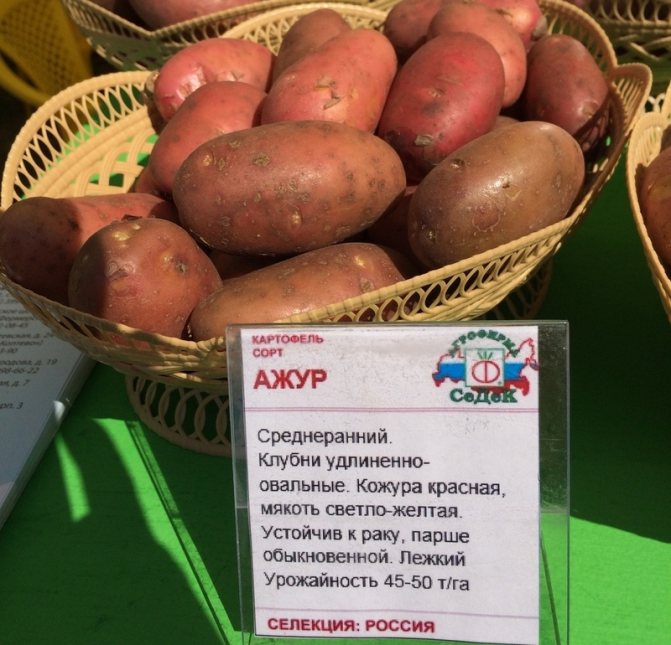

Potatoes Azhur
As a result of experiments on potatoes, new varieties began to appear, one of which was the seed potato Azhur Elite. Compared to other varieties, this is a completely young vegetable. It was withdrawn in Russia, in 2020 it was recorded in the state register of the Russian Federation. The cultivar was developed by the Sedek agricultural company.
It is recommended to grow the vegetable in the Central regions of the country. This includes areas such as:
- Moscow;
- Ivanovskaya;
- Vladimirskaya;
- Ryazan;
- Kaluga;
- Bryansk.
Since the variety ripens early, it can be harvested as early as July, which allows two harvests per year in the southern parts of Russia. What is a potato variety Azhur, the description of the variety will tell gardeners in detail.
Description of the variety
Roots:
- Tubers are oval, oblong;
- Dark pink peel, dense, smooth texture;
- Shallow eyes, superficially deepened;
- The pulp is light yellow;
- Starch content from 14 to 16%;
- Average weight 90-120 grams;
- Each bush produces 7 to 13 tubers.
Bushes:
- The plant is sprawling, vigorous, grows up to 45-55 cm;
- Dark green leaves, large in size, with a wrinkled structure and slightly wavy edges;
- Light lilac flowers form a compact corolla.
Growing features
"Openwork", like most varieties, needs to be illuminated by sunlight, this must be done 2 weeks before planting.Several times a season during warm winters it is necessary to cut off the sprouts. Planting is carried out from the end of April to May, when the soil has a temperature of about 13 degrees at a depth of 10 cm.
ATTENTION! You should not wait for hot days, an increased temperature, like a lower one, will negatively affect the germination and further development of root crops.
In the fall, the soil must be disinfected, fertilized and dug up with the removal of weeds. In the spring, you just need to dig it up - loosen it up.
IMPORTANT! Potato planting sites should not border on tomato plantings, and potatoes should also be planted from apple trees.
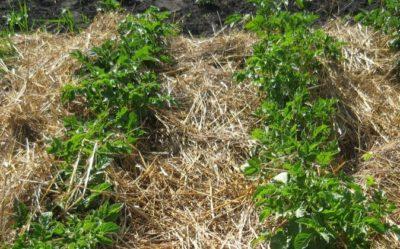

Mulching
Potatoes respond well to rested soil, after winter crops and legumes. Potatoes are planted in furrows or holes to a depth of 10 cm with the addition of wood ash. The distance between plants must exceed 20 cm. "Azhur" loves potash fertilizers.
Read about how to feed potatoes, when and how to fertilize, how to do it correctly when planting.
After planting, the potatoes can be treated with weed removers and retardants. When the first shoots appear, this will not be possible. To prevent the appearance of new weeds, mulching of the row spacings is used. "Azhur" tolerates drought well, but in dry summers, some irrigation will not hurt.
Potatoes should be spud, loosened, and excess grass removed. Several times a season, spraying with microbiological fertilizers is necessary (1 - when seedlings appear, 2 - during flowering). Flowers should be removed so that all growth goes to the roots.
We have prepared for you a whole series of articles on how to grow potatoes. Read all about the modern potato business and Dutch technology, how to grow early varieties and get a harvest without weeding and hilling.
And also interesting methods: under straw, in barrels, in bags, in boxes and from seeds.
Testimonials
Gardeners rate this potato positively, giving it good reviews:
- Alexey from Ryazan is just delighted with the variety. After planting only 10 tubers, he collected 20 large root crops from each bush. I liked the potatoes very much for their excellent taste.
- Marina from Ivanovo and her family also liked the Azhur variety with a good yield, large tubers and excellent taste. It has been noted that this potato grows better in loose soil and responds well to feeding.
The Azhur potato was created to replace the previously popular European varieties of this culture. And today it is widely used both for small personal gardens and for industrial plantings. And since this variety is unpretentious, it is perfect for those who will plant potatoes for the first time.
Landing
Azhur potatoes are planted in April-May, when the ground warms up to +12 degrees. It is undesirable to tighten with landing. High or low air temperatures have a negative effect on tuber germination. The potatoes are planted in a flat, well-lit area. The best predecessors of the crop are winter crops and legumes. Planting potatoes of the Azhur variety should not be near tomatoes and apple trees.
In the fall, humus or peat is added to the site at the rate of 1 bucket per 1 m2. Mineral fertilizers are also added: superphosphate, potassium sulfate and wood ash. After fertilization, the soil is disinfected, dug up and weeds are removed. You do not need to break the lumps. In the spring, the soil is loosened and leveled with a rake. The procedure facilitates the access of water and air to the roots of the plant.
Attention! Fresh manure should not be used for fertilization. Otherwise, the tubers will be watery and tasteless.
15 days before planting, openwork potatoes begin to germinate. Tubers are sorted out, sick and damaged ones are discarded. They are then cleaned and washed as bacteria can remain in the soil. The selected seed material is disinfected in a boric acid solution (1 tbsp. L. Powder per bucket of water).To activate the growth processes, the tubers are sprayed with a solution of potassium permanganate (2 g per 10 l of water) or an infusion of ash (2 glasses per 4 l of water). The potatoes are dried and removed to a bright place. The air temperature in the room should be from +12 to +16 degrees.
Azhura tubers are planted in holes or grooves to a depth of 5-10 cm.The interval between the bushes should be about 25 cm, and between the rows - 55-60 cm.If fertilizers were not applied during the autumn digging, they must be separately poured into each hole. This potato variety loves potash dressing.
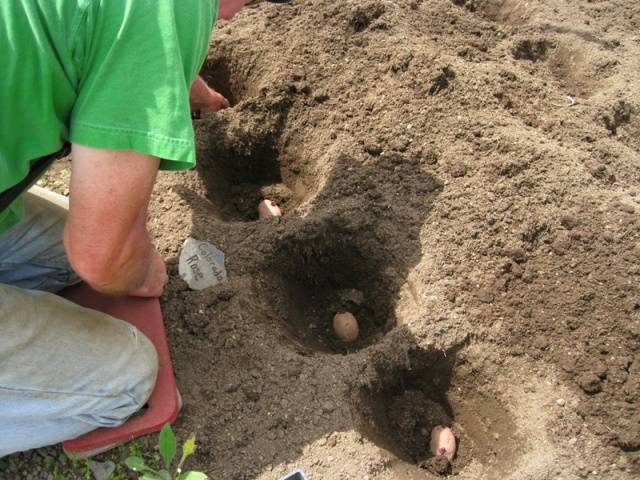

Features of planting and growing
For cultivation of the variety, well-lit areas with fertile land are chosen. The soil should be breathable, loose. In packed soil, the tubers will deform.
Potatoes grow well in slightly acidic or neutral soil. If the acidity of the soil is increased, wood ash is added to it when digging.
Preparing for landing
For planting, select healthy, without mechanical damage, even tubers of the same size. 20-30 days before planting, the tubers are germinated by placing them in a clean container in two layers and placing the containers in a warm room.
Before germination, potatoes are kept in a solution of "Fitosporin" and a slightly blue solution of copper sulfate to prevent the formation of fungal diseases during the growing season. The sprouted potatoes are re-sorted before planting.
Attention! Tubers on which no sprouts have appeared are not suitable for planting.
When the length of the shoots reaches 1-1.5 cm, they begin planting in open ground. To stimulate growth, the planting material is sprayed with a solution of "Epin" or "Zircon" before planting (4 drops of the drug per 1 liter of water).
Ground requirements
The variety is grown on any type of soil, but the best results are achieved on well-prepared, fertile, loose lands. A good harvest can be obtained when grown in black soil and sod soil.
To form a large number of tubers, the variety requires soil with the necessary amount of nutrients. Therefore, when digging up a plot, organic matter and mineral fertilizers are applied in the canopy.
Timing, scheme and landing rules
Planting of prepared tubers begins at the end of May, after the soil warms up to + 10 ° C to a depth of 12-15 cm. Planting dates vary in different areas depending on the onset of heat in the region.
For potato beds, choose a site well-lit by the sun. The earth is dug up three weeks before planting with the introduction of urea and wood ash. When planting, it is useful to pour 100 g of compost into each hole.
Attention! Cow dung is not used during and after planting, since fresh organic matter will burn young shoots.
The holes are located at a distance of 28-30 cm from each other. A gap of 60-70 cm is left between the rows. Sprouted tubers are carefully placed to a depth of 8-10 cm so as not to damage the sprouts. Sprinkle with loose soil on top.
At first, when the temperature drops at night, the potato beds are covered with foil, if necessary.
Growing features
To protect against a wireworm invasion, potatoes are planted after cereals, legumes, annual grasses, and lupine.
When planting, leave wide aisles (60-70 cm) for the convenience of performing agrotechnical work, for better lighting and aeration of the bushes.
Important! The planting depth of tubers depends on the composition of the soil. In soddy soil and black soil, tubers are laid to a depth of 6-7 cm, in light sandy loam soils - by 10-12 cm.
Before landing, be sure to check the depth of groundwater. The water level should be at least 75-80 cm from the soil surface.
The soil for planting potatoes begins to be prepared in the fall. Thoroughly remove all plant residues and weeds, dig deep into the soil with the simultaneous introduction of organic matter and mineral fertilizers.
The main nuance in growing this variety is its need for good soil moisture. When watering, it should be borne in mind that the need for moisture changes during the growing season.
Good results are obtained by mulching the beds.... A layer of 6-7 cm will prevent weeds from growing and protect the soil from drying out.
Watering mode
Before the emergence of seedlings, the soil is not moistened, since watering during this period will lead to superficial growth of the root system.
The first watering is carried out when the young tops reach 6-7 cm in height. Water the seedlings with small portions of warm water under each bush. Moreover, it is necessary to ensure that the water does not wash the tubers onto the surface. About 2 liters of water are poured under each plant.
Before flowering, potatoes are watered depending on the drying out of the soil, on average - 1 time in 8-9 days.
Reference. If the site has sandy soil, it is watered more often, since such land dries up faster than sod and black soil.
During the flowering period of the culture, plants need more moisture, since during this period tubers are formed. If there is a lack of moisture, the tubers will be few and they will not grow to the proper size.
How to plant?
Planting this variety should start in April or May, it all depends on the warming up of the earth. The optimum soil temperature is 12 degrees Celsius. Land for landing should be level and well lit. It is best if the predecessor of the potato is a winter or legume crop. Do not plant potatoes next to a tomato and an apple tree.
If you plan to plant in 15 days, then be sure to sort out all the tubers, removing the diseased and damaged ones. After they should be washed and disinfected with a mixture of boric acid and water. To make the tubers grow better, they can be sprayed with potassium permanganate. Then the potatoes are dried and laid out in a lighted place with a temperature from plus 12 to 16 degrees.
Each Azhura tuber must be planted in a hole with a depth of up to ten centimeters with a distance of 0.25 m between the bushes. An interval of about 0.6 m must be observed between rows. each individual hole.
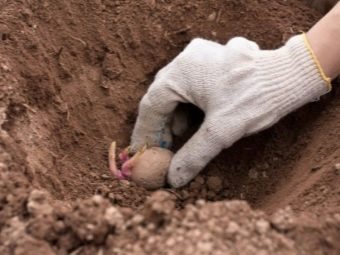

How to care for a plant?
"Openwork" refers to an unpretentious potato variety, so minimal care procedures will be enough for it. Experts refer to several activities as the main procedures.
- Loosening is necessary so that harmful plants do not appear on the site. Such work will saturate the soil with oxygen, which is necessary for good growth.
- Hilling. Potato roots grow not only in the depths of the soil, but also to the sides. To avoid damage and protect the root from the parasite, it is worth hilling the bushes. You need to carry out the procedure every week until the hill reaches a height of 0.2 meters.
Features of agricultural technology
Potatoes are grown in over a hundred countries around the world. The standard agricultural technique for growing this popular vegetable crop in Russia assumes compliance with the following recommendations:
- planting potatoes is carried out only after the soil warms up to positive temperatures;
- the soil for potatoes should be loose and fertile, with sufficient aeration and water permeability;
- the scheme for planting potatoes using the shovel method assumes a distance between potato bushes and rows of about 50-60 cm, which allows the plants to provide a sufficient feeding area;
- irrigation measures should be properly organized, given that the standard moisture requirement of this vegetable crop at different periods of growth and development differs;
- an excess of the normative amount of nitrogen fertilizers in the phase of active development of plants can have a negative effect on the quality parameters of the grown potatoes, therefore, feeding with such means should be replaced with the introduction of organic matter and mineral fertilizers.
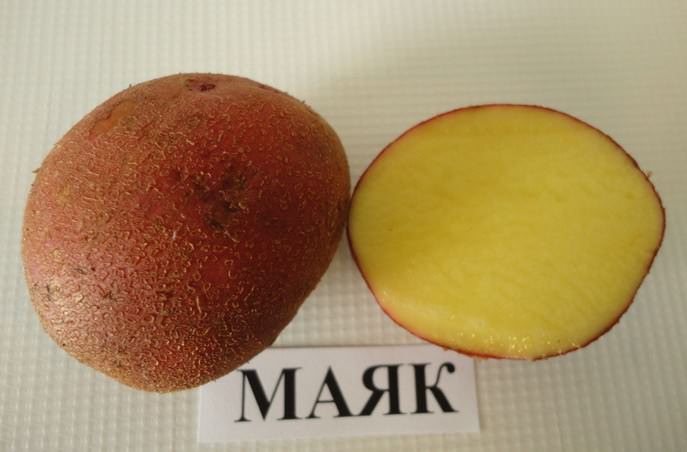

When growing potato varieties "Mayak", it is advisable to adhere to the presented standard rules.
After reading the corresponding article on our website, you can also learn about the varietal characteristics of the high-yielding potatoes "Good Luck".
Care
Azhur potatoes are unpretentious, so it is enough to provide him with minimal care. It includes hilling, watering, loosening and removing weeds.
Watering and loosening
Despite the fact that this variety tolerates a lack of moisture well, in a dry and hot summer, watering will only benefit. Irrigation is carried out during the period when the sun is least active - in the early morning or late evening. On average, 1 m2 requires about 45-50 liters of water. Typically, the crop is irrigated every 10-14 days, and during drought, every 4-5 days. With sufficient rainfall, you can limit yourself to three waterings per season.
A few days after irrigation, the soil must be loosened, otherwise a crust will form on the surface of the earth. Gardeners also recommend mulching between rows. The procedure will help retain moisture and prevent weeds.
Hilling
Azhur potatoes require at least two hilling with an interval of 21 days. In some cases, the number of procedures can increase up to four times. Work is carried out in cloudy weather, while the ground should be wet.
The bushes begin to huddle when they grow up to 8-12 cm. Re-hilling is carried out when the shoots reach 25 cm in height. But before the planting procedure, they are cleared of weeds.
Important! During the flowering of potatoes, hilling should be carried out carefully, since during this period the formation of tubers occurs. Any careless action can damage them.
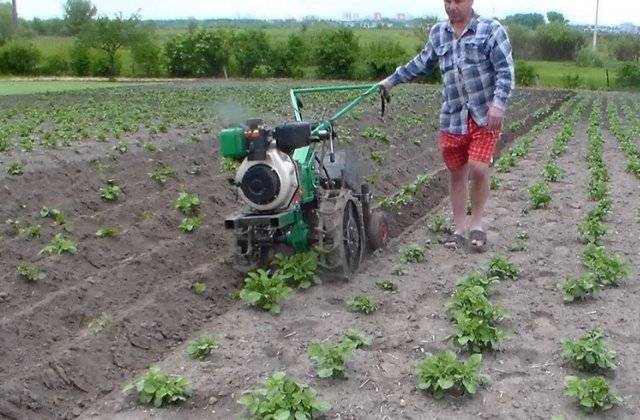

Top dressing
Variety Azhur has a positive attitude towards fertilization. In order to achieve the desired effect, the potatoes need to be fed at each stage of their maturation. After the emergence of seedlings, organic matter is introduced into the soil. Manure or poultry droppings are diluted in water in a ratio of 1:15 and infused for two days.
Before flowering, potatoes are fertilized with a solution of 1 tbsp. l. potassium sulfate, 3 tbsp. l. wood ash and 10 liters of water. Some gardeners prefer to spray the bushes with a urea solution (300 g per 10 liters of water).
During the flowering period, both mineral and organic fertilizing can be applied to the soil. You can apply the following composition: two tablespoons of superphosphate, a bucket of water and a mullein.
Care features
Caring for growing potatoes is to cultivate the soil near the plants in time and to irrigate, as well as prevent the development of weeds. The vegetable grower closely monitors the development of plants and controls the number of pests on them.
Fertilization and Watering Frequency
If the soil has not been pre-filled with fertilizers, the bushes are fed during the growing season. Organic or mineral substances are scattered under the bushes in the root zone shortly before weeding. During the treatment of the soil, fertilizers are mixed with the soil, and after the rain, having dissolved, they fall directly to the roots of the plants. During the growing season, potatoes are fertilized twice: the first fertilization is carried out before the flowering of the bushes, the second fertilizing is served to the plants 3 weeks after the first.
Read more on how to properly water potatoes with your own hands.
In the southern regions, potatoes are grown on artificial irrigation... Without watering in hot conditions, this culture does not tie root crops well. The most successful irrigation method is the use of a drip system. Drip irrigation allows moisture to get directly to the roots of the plant without spreading, and also to combine the introduction of mineral and organic liquid fertilizers with irrigation. In the south, potatoes must be watered at least once every 10 days, using at least 2 liters of water per 1 bush.
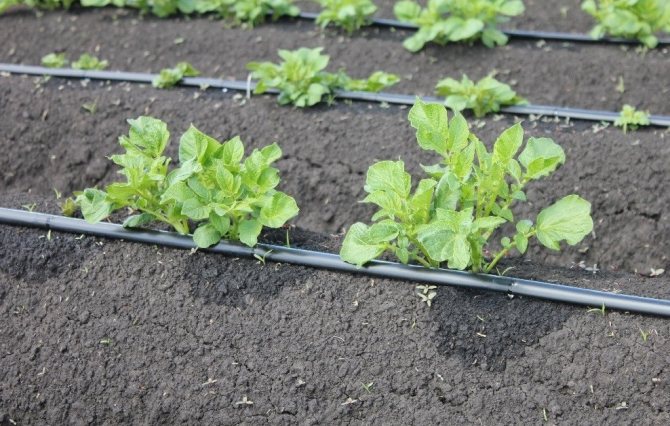

Weed cleaning
During the growing season, potatoes need to be weeded periodically. Weeding helps keep the soil under the bushes clean and free of weeds, which draw off some of the nutrients and moisture.
Usually, for the entire growing season, two procedures are carried out:
- immediately after the first green potato sprouts appear on the surface of the beds, after the entire potato row is indicated;
- before flowering - usually this weeding is combined with hilling bushes.
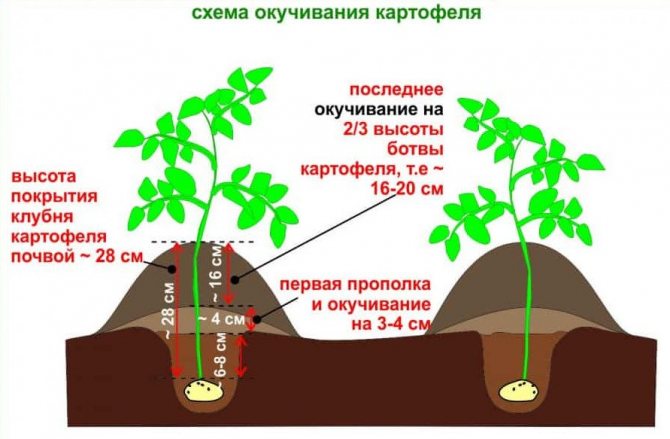

Loosening and cleaning the soil from weeds is carried out using a hoe with a wide and sharp blade or Fokin's flat cutter No. 3. On large private potato fields, small walk-behind tractors are used, which greatly facilitates the work of farmers.
After the potatoes have faded, no work is carried out with the soil in the aisles and under the bushes.... This is due to the fact that by this time the bush becomes tall and lush and soil treatment can damage it. There is also the possibility of damage to the underground stolons with the sharp metal blades of garden tools.
Mulching is used on small backyard potato beds in the southern regions, which avoids overheating of the soil and reduces the need for irrigation. Potato aisles are covered with mulch... As organic mulch, you can use last year's straw, sawdust from non-deciduous trees, rotted leaves from the garden.
We recommend that you find out if you can pick flowers from potatoes.
You can also use inorganic mulch, such as narrow sheets of double-sided non-woven agrofibre (spunbond or other agrotextile). One side of such agrotextile is painted black (the non-woven material is placed against the soil), and the other is white (facing upwards). The black color of the lower part of the panel will not allow weed seeds to germinate, and the white colored side will prevent the soil from overheating.
In autumn, after harvesting, organic mulch can be left in the beds - later it will be embedded in the soil, where it will rot, enriching the soil with nitrogen. Agrofibre, used as mulch for potato rows, is carefully harvested before harvesting, washed in water, dried, rolled up and stored until the next season.
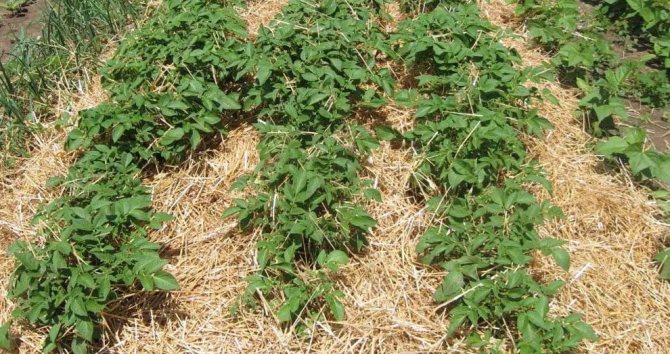

Pest and disease control
To prevent the development of diseases, plants are treated with chemicals containing fungicides (Ridomil Gold, Quadris). The procedure can be combined with the treatment of the potato field from insect pests.
The most dangerous pest of potatoes is the larvae of the Colorado potato beetle... After their hatching, the bushes will need to be treated on a leaf with one of the insecticides ("Karate", "Aktara", "Stop Beetle"). If the summer is very hot and the eggs laid by beetles quickly turn into a new generation of actively chewing larvae, then the processing of the potato field is repeated one or two more times (if necessary).
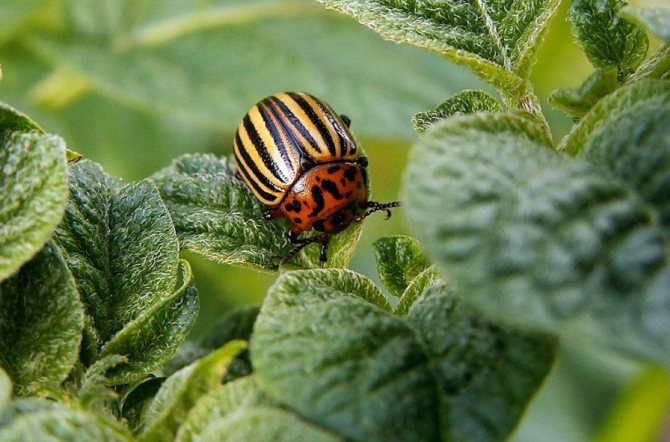

Characteristics
It is considered a high-yielding variety. Under favorable conditions and proper care, it is possible to collect up to 50 tons per hectare. In the first digging of potatoes aged about 40 days, you can collect about 130 centners per hectare. There are practically no small tubers, the potatoes are even in size.
Productivity is one of the main indicators when growing potatoes. Compare this characteristic of the Azhur variety with other varieties:
| Variety name | Yield |
| Openwork | 450-500 c / ha |
| Grenada | 600 c / ha |
| Innovator | 320-330 c / ha |
| Melody | 180-640 c / ha |
| Hostess | 180-380 c / ha |
| Artemis | 230-350 c / ha |
| Ariel | 220-490 c / ha |
| Vector | 670 c / ha |
| Mozart | 200-330 c / ha |
| Borovichok | 200-250 c / ha |
"Azhur" is a table variety. Due to the medium starch content, the tubers do not boil over, ideal for making soups, salads, whole cooking, frying. "Azhur" does not darken after cooking.
Attention! The peel of a potato contains more beneficial trace elements than the tuber itself. The most beneficial way of cooking is to boil or bake in the skins.
Potatoes contain a lot of useful substances, most of all - vitamin C. The juice of raw potatoes will help lower blood pressure, It is used in cosmetology as a mask against edema and for skin whitening. "Azhur" has a rich taste and a pronounced aroma.Reviews about the taste of potatoes are only positive.
Read all about the properties of potatoes on our website.
Why is solanine dangerous, what are the benefits and harms of raw potatoes, what are the health benefits of the juice and sprouts of this vegetable.
Potato varieties for SPRING 2020
Dear Customers! Note! Potatoes available in the store are in limited quantities... If you need a significant amount of planting material, make a preliminary request. Use the button "ONLINE-order".


CERTIFIED potato varieties for the 2020 season. We accept applications!
MINI CLUBS -obtained from virus-free microplants in greenhouses or in hydroponic modules, healthy, pure-quality planting material of excellent varieties. PC1 - first reproduction, PC2 - second reproduction.
Potato variety SANTE - Mini tubers, 10 pcs. RUB 90 ENDED!
The tuber and flesh are light yellow in color, the surface is smooth, without roughness. The starch content is 10 to 14 percent. Variety "Santa" is medium early, the period of tubers ripening from the moment of germination is 80-90 days.
Resistance to various diseases affecting potatoes is quite high. So, to the scourge of all gardeners and truck farmers - late blight, the variety is very resistant. Practically unaffected by potato cancer and nematodes.
Describing the taste of the "Santa" potato variety, we can say that its taste is excellent. It’s not for nothing that “Santa” is used for French fries in fast food restaurants. At home, this potato makes a delicious fried potato with a golden crisp crust. For the preparation of mashed potatoes, "Santa" is also suitable, but it will take longer to cook than those varieties in which the content of starch is higher.
Potato variety ROSARA - 80 rubles. per 1 kg - (PC1)
Early (65-75 days) table variety.
- The shape of the tubers is elongated-oval, the peel is red, with a shallow arrangement of eyes, the flesh is yellow. - Starch content 17-19%. Smoothness is weak, taste is excellent. - The variety is resistant to mechanical damage during harvesting.
Potato variety RED LADY - 80 rubles. for 1 kg. (PC2) OVER!
Potato variety "Red Lady" German selection, entered in the State Register of Varieties of the Russian Federation, early maturing (75-85 days), table, high-yielding .. Under a potato bush "Red Lady" up to fourteen pieces of large potatoes with an average weight of 114-142 g can be grown. The proportion of small tubers is small. Potato tubers varieties "Red Lady" an attractive elongated-oval shape with a red, slightly reticulate and, as it were, peeling, peel, on which the superficial eyes are located. The pulp has an appetizing yellow color, good and excellent taste, high starchiness - 12.5 - 16.8%, does not darken after heat treatment, Seed potatoes of the variety "Red Lady" resistant to drought, to secondary growth, to diseases of rot, late blight, scab, rust, black leg, various viruses. Tubers "Red Lady" not prone to the formation of dark spots inside the tuber, resistant to mechanical damage. Potato varieties "Red Lady" suitable for long-term storage, as it has excellent keeping quality.
Potato variety LABELLA - 110 rubles. for 1 kg. (PC1) NOT AVAILABLE!
Potato varieties "Labella" recognized as an early ripening table variety, characterized by rapid development at the initial stage of growth and a friendly return of a high-quality harvest.
The bush forms up to fourteen tubers, and both very small and very large tubers are almost absent in the nest. The color of the tuber is bright, red, with shallow eyes, the shape is convenient for cleaning, elongated-oval, the flesh is yellow, appetizing, does not darken during cooking, slightly boiled, of excellent taste. Starch content is below average, about 12%.
Seed potato varieties "Labella" has resistance to cancer, various viruses, scab and rot, resistant to heat, has a high yield, and the marketability of this variety is excellent.The keeping quality of the tubers of this variety is very high, which makes it possible to realize the harvest at any time.
Potato variety NATASHA - 100 RUB. 1 KG (RS1)
Early, slightly boiled table potato with oval, lined tubers, yellow skin, yellow flesh and shallow eyes. The yield is high. NATASHA is highly resistant to rhizoctonia, blackleg and tuber rot.
Potato variety LAYAK - Mini tubers, 10 pcs. RUB 90
Morphological signs:
- Plant of medium height, semi-erect, medium anthocyanin coloration of the stem
- Medium leaf, dark green
- Medium-sized inflorescence, medium-flowered
- Corolla red-violet
- The tubers are oval, the peel is red, smooth, the eyes are red, small, the flesh is white, does not darken during cooking
Economic and biological characteristics:
- Mid-early, canteen
- Productivity up to 45 t / ha, starch content 13-16%
- Good taste, little digestibility (type CB)
- Resistant to cancer, golden cyst-forming potato nematode. Moderately resistant to late blight, relatively resistant to common scab
- Originator: GNU Ural Research Institute of Agriculture of the Russian Agricultural Academy
IMPALA potatoes - 110 RUB for 1 kg. (PC2) - NOT AVAILABLE!
Tuber shape oval Skin color Yellow Flesh color Light yellow Eyes Small Yield, q / ha 180 - 360 Number of tubers per 1 bush 16 - 21 Yield of marketable tubers,% 89 - 94 Keeping quality High Starchiness,% 10 - 14 Weight of marketable tubers, g 90 - 150
Potatoes RED SCARLET -Mini tubers, 10 pcs. RUB 90
Early ripening, high yield, large number of tubers, high marketability, good keeping quality, and washable.
Characteristics of the variety Early maturity: Early growing season: 70-75 days Tuber shape: Elongated-oval Tuber size: Medium-large / large Skin color: Red Flesh color: Yellow eyes: Small type of preparation: Non-crumbly / slightly crumbly discoloration after cooking : No shelf life: Good
LEONI potatoes - 80 rubles for 1 kg. (PC1)
Early maturing, for dining purposes. Plant of medium height, leaf type, semi-erect to spreading. Medium to large, closed leaf, green to dark green. Low to medium waviness. Corolla medium to large, reddish purple. Marketable yield 17.8-34.6 t / ha. The maximum yield is 35.6 t / ha. The tuber is oval with small to medium-sized eyes. The rind and flesh are yellow. The mass of the marketable tuber is 81-130 g. The starch content is 14.7-15.0%. The taste is great. Marketability 94-95%. Keeping quality 97%.
IRBITSKY potatoes - Mini tubers, 10 pcs. RUB 90 ENDED!
120 RUB 1 kg (SUPERELITE) IS ENDED!
Mid-season, for dining purposes. Plant of medium height, intermediate type, semi-erect. Medium to large leaf, intermediate, dark green. The waviness of the edge is strong. Corolla of medium size, strong anthocyanin coloration on the inside.
Marketable yield of 252-400 c / ha, at the level of the Korona standard and 104 c / ha higher than the Nevsky standard. The maximum yield is 468 c / ha, 178 c / ha higher than the Nevsky standard (Nizhny Novgorod region). The tuber is rounded with small eyes. The peel is red. The pulp is light yellow. The mass of the commercial tuber is 108-185 g. The starch content is 13.0-16.5%. The taste is good.
Marketability 81-96%. Keeping quality 97%.
Potato variety RODRIGO - Mini tubers, 10 pcs. RUB 90 NOT AVAILABLE!
A variety of German origin. The variety is heat and drought resistant. And this is a great advantage for places where it is not possible to irrigate.
Potatoes of this variety are early ripening. The plant has a semi-erect stem. The plant is medium to high. The flowers are reddish-purple and the leaves are medium. The tubers are oval in shape. The color of the peel is red, bright red. The pulp is creamy. The yield is excellent. The number of tubers in a bush is up to 9 pieces. The mass of each tuber is 500-700 grams.
The starch content is 12.5 - 15.4%.Rodrigo potatoes have a high keeping quality of up to 95% and excellent taste. This variety is resistant to viruses and cancer.
Potato variety SKARB Mini-tubers, 10 pcs. 90 rubles ENDED!
Potato variety "Skarb" - mid-season table variety, salad type. Bred in Belarus. Bush of medium height, intermediate type. The leaf is medium sized, open, dark green. Bush of medium height, intermediate type. Medium leaf, open, dark
green. The leaf is medium in size. Tubers are oval, yellow peel, smooth, small eyes, weight 150-200 g, up to 20 pieces per plant. High productivity. Excellent taste. Resistance to disease damage. Excellent storage performance.
Potato variety NEVSKY 80 rubles. 1 kg (PC1) ENDED!
Variety "Nevsky" - medium early (80-90 days), high-yielding table variety with high marketability and excellent taste. Bush: The bush is low, compact, erect, with numerous strongly branching stems, white flowers.
The tubers are round-oval in shape, with red eyes and a blunt tip. The peel is white, the flesh is white, does not darken during cutting, the starch content is 10.7-14.8%. The mass of the marketable tuber is 90-130 g. It is easy to wash and clean. They do not crumble during cooking. Not recommended for frying and mashed potatoes, better in soup and salads. The tubers are well preserved.
Marketability - 90-95%, yield - 38-50 t / ha. Potential productivity up to 1.5 kg per bush. The variety is resistant to rhizoctonia, moderately resistant to late blight, common scab. Resistant to drought and waterlogging.
Potato variety LYUBAVA - Mini tubers, 10 pcs. 90 rubles ENDED!
Included in the State Register for the West Siberian (10) region. Early maturing, for dining purposes. Plant of medium height, intermediate type, semi-erect. The leaf is small, open. The leaf is small.
The maximum yield is 524 c / ha, 134 c / ha higher than the Aksamit standard (Tomsk region). The tuber is oval-rounded with eyes of medium depth. The skin is red, medium to coarse. The pulp is white. The mass of the commercial tuber is 109-210 g. The starch content is 11.2-16.9%, the taste is good. Keeping 95%
Potato variety LUCK 100 rubles 1 kg ENDED!
One of the best and most popular varieties of Russian selection... Differs in early maturity, productivity, plasticity, versatility of use.
It is cultivated in all natural and climatic zones, due to its high adaptability to conditions, it gives a guaranteed high yield of 500-600 c / ha.
Tubers cream-colored, round-oval, smooth, small eyes. Pulp white.
With early digging on the 45th day after germination, the yield is 18-20 t / ha. Weight marketable tuber 120-150 g. In the nest 10-15 pieces, marketability 96-100%. Starch content 12-15%. Good taste. The preservation is high.
Potato variety NAKRA - RESISTANT TO THE COLORADIAN BEETLE! Mini tubers, 10 pcs. 90 rubles ENDED!
Mid-season, suitable for making crispy potatoes. The plant is tall, intermediate type, erect. Medium-sized green leaf. Medium leaf
The maximum yield is 399 c / ha. The tuber is oval-rounded, the eyes are of medium depth. The skin is smooth to medium-rough, red. The pulp is light yellow. The mass of the commercial tuber is 65-160 g. The starch content is 18.2-21.9%. The taste is good. Marketability 83-95%, at the level of standards. Keeping quality 95%.
Potato variety RYABINUSHKA - NOT AVAILABLE!
Medium early, for dining purposes. Medium to tall plant, intermediate type, semi-erect. Medium to large leaf, open, dark green. The maximum yield is 396 c / ha. The tuber is oval with small eyes. The peel is smooth, red. The pulp is creamy. The mass of the marketable tuber is 91-133 g. The starch content is 11.9-15.0%.
The taste is good. Keeping quality 95%.
Potato variety SNEGIR Mini tubers, 10 pcs. 90 rubles ENDED!
Included in the State Register for the North-West (2) region for garden plots, home gardens and small farms. Early maturing, for dining purposes. Plant of medium height, intermediate type, erect to semi-erect. The leaf is large.
Productivity 180-271 kg / ha. Forms tubers together. The tuber is oval-rounded, the eyes are very small to small.
The rind is smooth to medium, red. The pulp is white. The mass of the marketable tuber is 59-90 g. The starch content is 15.7-16.0%, 0.3-0.6% higher than the standard.The taste is good and excellent. Marketability 65-85%, at the standard level. Keeping quality 95%.
Potato variety BELLAROSA Mini tubers, 10 pcs. 90 rbl
Early ripe, 55-65 days, for dining purposes. The tuber is oval-rounded, the eyes are small. The peel is slightly rough, red. The pulp is light yellow. The mass of the marketable tuber is 117-207 g. The starch content is 12.6-15.7%. The taste is good. Keeping quality 93%. Resistant to the causative agent of potato cancer and golden potato cyst nematode.
Dormant period of tubers: average. Very good keeping quality for such an early variety.
Potato variety KAMENSKY RUB 50 1 kg (PC2) OVER!
VARIETY OF POTATO THAT IS NOT DAMAGED BY THE COLORADIAN BEETLE.
A novelty of the Ural selection. Most of the parameters of this variety deserve the highest grade. First of all, it is one of the few varieties resistant to the Colorado potato beetle. But this is not a virtue for which I had to sacrifice something. Obviously, the beetle does not like strong, upright plants with large, stiff leaves. But we really like that the variety gives an excellent harvest of tasty, elongated-oval, red tubers, with a slightly reticulated skin and light yellow inside.
Potato variety CIFRA - Mini tubers, 10 pcs. 90 rubles ENDED!
Medium late, for dining purposes. Medium to tall plant, intermediate type, erect to semi-erect. Medium-sized leaf, intermediate, dark green.
The maximum yield is 533 c / ha. The tuber is rounded with eyes of medium depth. The peel is yellow, smooth. The pulp is white. The mass of the commercial tuber is 107-150 g. The starch content is 11.2-15.9%.
The taste is very good. Keeping quality 96%.
Potato variety SYMPHONY Mini tubers, 10 pcs. RUB 90 ENDED!
Medium early, red, highly productive variety. Tubers are oval in shape, with superficial eyes and light yellow flesh. Possesses good taste, especially when boiled. It brightens slightly when cooking. High dry matter content. Leaves and tubers are well resistant to late blight. Well resistant to virus Y, very resistant to scab and mechanical damage. Resistant to golden nematode.
Potato variety ZEKURA - ELITE 100 rubles. 1 kg ENDED!


Medium early, table grade. The bush is semi-erect, the color of the corolla is red-violet. Tuberous nest compact, superficial, oblong tuber, yellow peel, yellow flesh, small eyes. Productivity 550-600 kg per hundred square meters, high marketability 96%. Starch content 13-18%. Resistant to potato crayfish, golden nematode, relatively resistant to common scab. The variety has excellent shelf life and does not lose table quality, ideal for market sales.
Potato variety GALA ELITE - 110 rubles. 1 kg ENDED!
An early table variety with good taste, ideal for washing. The plant is semi-erect. Tuber shape - Round-oval to oval. The color of the tubers is yellow. The color of the pulp is yellow. Early ripe (75 - 80 days) up to 25 tubers per plant. Keeping quality: excellent. Taste: excellent. Productivity: high. Variety value: resistant to nematodes and potato cancer, slightly susceptible to leaf-rolling virus, weakly affected by virus "U" and "A", resistant to late blight of tubers. Great taste
Potato variety KARATOP - ELITE - 110 rubles. 1 kg. ENDED!
Early maturing, for dining purposes. A bush of medium height. Stem coloration is absent or very weak. The leaf is medium, intermediate. The corolla is white. Forms tubers together. The maximum marketable yield is 494 kg / ha. The tuber is oval-rounded, with small eyes. The rind is yellow, smooth to medium. The pulp is light yellow. The mass of the commercial tuber is 58-105 g. The starch content is 10.6-14.4%. The taste is good. Marketability 72-93%. Resistant to potato crayfish, golden potato nematode. Resistant to viruses, slightly susceptible to late blight in tops and tubers. The value of the variety: nematode resistance, resistance to viruses, amicable recoil of early production, good taste of tubers. Suitable for difficult soils.
Potato variety ROMANCE Mini tubers, 10 pcs. 90 rubles NOT AVAILABLE!
The originator of the table mid-season potato variety Romance is NORIKA GmbH. Frisch (Germany). The variety has been included in the register of breeding achievements of the Russian Federation since 2008. Biological features: the plant is semi-erect. The tubers are oval.The color of the tubers is red, the color of the flowers is red-violet. The pulp is light yellow to yellow. The mass of a commercial tuber is 120-160 grams. The number of tubers is 14-18 pieces. The starch content ranges from 13-19.9%. Romance potatoes have good taste, predominantly firm texture after boiling. Tubers darken slightly after boiling. The Romanze potato yield reaches 53 tons per hectare. Marketability from 83 to 96%. Keeping quality reaches 91%. The variety belongs to well-tolerated storage. Potatoes of the Romance variety are resistant to the causative agent of cancer and the golden cyst nematode, moderately susceptible to the causative agent of late blight in the tops and tubers, highly resistant to rhizoctonia, various viruses. Potato Romance grows well on all types of soil, responsive to increased doses of fertilizers and watering. The variety is characterized by uniform emergence and fast growing tops. It is recommended to remove the tops 12-15 days before harvesting. Romance potatoes are distinguished by their plasticity to soil and climatic conditions.
Potato variety ROSALIND Mini tubers, 10 pcs. 90 rubles ENDED!
Early variety. The tubers are reddish and the flesh is pleasant yellow. The number of ocelli is moderate, and they are not deep. The average weight of one tuber is 100 grams. The starch content is quite high - more than 17%. Culinary variety. Does not darken after cooking. High yield allows harvesting more than 50 tons of potatoes from one hectare. This variety is considered one of the most successful for growing in your own garden, because does not require strong maintenance, while giving a relatively high yield. It is also highly valued by culinary experts and is very often purchased in large quantities by restaurant establishments.
Potato variety ISL of JURA Mini-tubers, 10 pcs. 90 rubles ENDED!
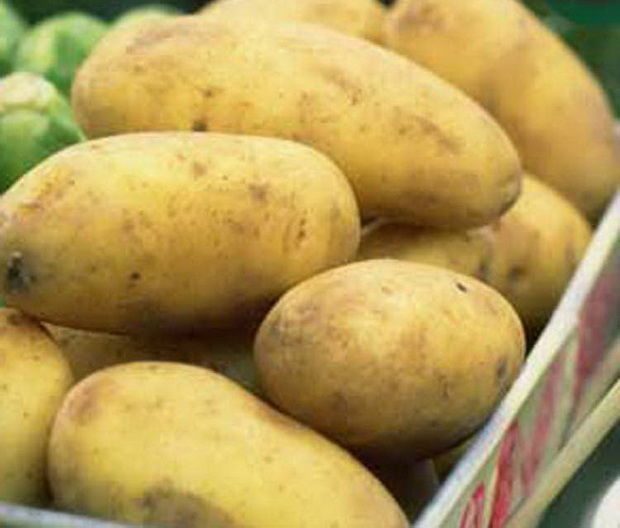

Mid-early (period from germination to technical maturity 60-80 days), table variety of potatoes. Included in the State Register for the Central Region. Plant of medium height, intermediate type, semi-erect. The leaf is large, intermediate, dark green. The waviness of the edge is medium. The flower is large, white. The tuber is oblong-oval with very small eyes. The peel is rough, yellow. The pulp is light yellow. The mass of the marketable tuber is 88-192 g. The starch content is 12.0-16.2%. The taste is good and excellent. Marketability 77-98%. Keeping quality 95%. Marketable yield 248-338 c / ha. The maximum yield is 415 c / ha (Vladimir region). Resistant to the causative agent of potato cancer and golden potato cyst nematode. According to the All-Russian Research Institute of Phytopathology, it is moderately susceptible in tubers to the causative agent of late blight.
Potato variety ZHUKOVSKY EARLY - ELITE 110 rubles. 1 kg ENDED!
This potato belongs to the group of "pink varieties". The culture is resistant to most diseases: late blight, scab and others, moreover, it has a small waste during storage. The tubers are oval in shape, the skin is smooth, the pulp does not darken when cutting.
The main advantage of the early Zhukovsky is its taste, and there is practically no waste when peeling the peel. Let's dwell on the description of the variety.
The culture bush is small, semi-spreading. There are few stems, but they have many branches. The leaves are very dissected, large, dark green in color, slightly pubescent with clearly visible veins. The culture does not bloom for long, but massively. The inflorescence has many compactly folded flowers. The corolla of the flower is red-purple at the tips with white stripes. The fruit after the flower is absent.
The skin of the tubers is smooth, the tubers themselves are in the shape of an oval, which ends with a blunt tip. It is impossible to accurately determine the color of the tubers of the culture, it can be red or have a pink tint. There are few eyes on the tubers, they are usually small. When the potato is cut, the flesh does not darken, it has a white color.
The maximum yield of the variety is 38 tons per hectare, tuber weight reaches 170 grams, starch - up to 15%.Zhukovsky early is well stored, its indicators are 92-96%. In addition, the tubers are not afraid of mechanical damage, having an output of 90% of high-quality potatoes. It should be noted that this variety is resistant to nematodes and cancer.
Potato variety JELLI-ELITE 100 rubles. 1 kg ENDED!
Jelly potatoes are a table and mid-season variety. The bushes of the plant are tall, they can be of two types: spreading or semi-erect. Green leaves can be of different sizes (from medium to large) and also vary in type from intermediate to open. They have a medium waviness of the edges. A medium-sized corolla is formed on top of the bush, blooming with white flowers. The growing season for "Jelly" potatoes is 90 days, but with the use of nitrogen fertilizers it can increase, so fertilizing should be done with magnesium.
Tubers are even, oval, medium in size with small eyes. Their peel is yellow, it may be slightly rough, but more often it is smooth. The dark yellow flesh tastes great. The starch content is about 17%.
The yield is consistently good (one might even say very high) - 15 pieces under one bush, with the weight of one potato ranging from 84 to 135 grams, there are practically no small ones. Approximately 45-60 tons per hectare is harvested, so it is perfect for growing on an industrial scale.
The level of marketability of tubers (95%) and normal keeping quality (86%) also contribute to the popularity for large-scale production.
A feature of this variety is that throughout the entire storage period, potatoes do not change their characteristics: appearance and taste.
Potato variety LUX - 120 rubles. 1 kg (SUPERELITA)
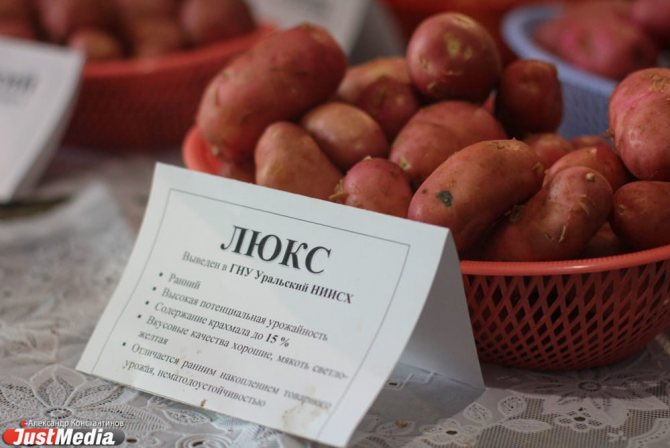

Medium early variety, red peel, yellow pulp, crumbly when cooked. Resistant to potato crayfish and potato nematode. Achievement of the Ural selection! NEW 2020!
Patent holder: Russia Ural Research Institute of Agriculture.
About diseases and pests
Despite its resistance to scab and potato crayfish, growing problems can still arise. The most common lesions are certain diseases.
- Golden nematode. The main symptom of the disease is yellowing of the bushes and growth retardation. At the same time, the leaf dries up and can curl. As a result, small tubers are formed. Such a plant must be dug up and disposed of. If this method does not help, then it is worth using chemicals.
- Late blight. Brown spots appear on the leaf and stem. If the humidity is high, white bloom can also be observed. The potato tuber has numerous depressed spots. To save the plant, the use of Quadris and Ridomil Gold is recommended. And also effective spraying with "Fitosporin" and "Trichodermin".
- Alternaria, when dry brown spots are noticeable on the foliage and stem, and large depressed spots on the root crop. To avoid this problem, before planting, you need to treat the tubers with a chemical such as "Baktofit" or "Integral".
The Colorado potato beetle, wireworm, bear and moth most often harm potatoes. The most common and beneficial drugs are considered to be "Regent", "Aktara" and others.
